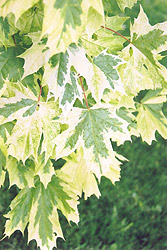Maple trees are one of the most recognizable trees. Not only do they have that familiar leaf shape, they also have a strong opposite branching habit and unique fruit called samaras (also known by kids as ‘helicopters’).
Maples make wonderful landscape trees and add great value to any property. Picking the one to plant depends on the height and shape you want in your yard. Fall color is also a huge selling point for gardeners.
If you’re looking to plant trees for future syrup production, sugar maple should be your top choice. However, red, silver and box elder maple trees work as well. Sugar maple sap has the highest percentage of sugar. Ornamental maples have a milky sap and cannot be used.
Sugar Maples Acer saccharum
Prefer rich, well-drained soil and do not do well in compacted soil or heavy clay. They are also not tolerant of drought, salts or pollution. This hardwood tree grows relatively slowly. The sap has the highest sugar content so the most commonly used tree for syrup. 50-75’ Tall x 50’ Wide, Upright and Rounded Form, dark green foliage, fall color is spectacular and ranges from rich yellows to shades of oranges and reds
Fall Fiesta Sugar Maple – 50-75’ Tall x 50’ Wide, upright and rounded shape, glossy, leathery green foliage, fast grower, resistant to sun scald and frost cracks, fall color has more oranges and reds than other sugar maples, Zone 3
Red Maples Acer rubrum
A very tolerant type of maple that adjusts to a wide range of soil conditions even if it is usually found in naturally in moist soils like wetlands and swamps. Optimum growth is in slightly acidic soil. This vigorous grower puts on 2-3 feet per year.
Native Red Maple – 50′ Tall x 35-40′ Wide, Upright, Rounded Shape, showy red flowers in spring and awesome scarlet or yellow fall color. Fast growing native tree does best in partial shade and moist soils, Zone 4.
Autumn Flame – 40-50′ Tall x 40′ Wide, Dense, Rounded Shape, uniquely small leaves. A male selection that provides an early source for pollinators in the spring but bears no fruit. Early crimson fall color, Zone 4.
First Editions Scarlet Jewell – 70′ Tall x 30′ Wide, upright habit. Showy red flowers in spring, deep crimson red fall color 2 weeks earlier than other red maples and resistant to frost cracking. Zone 3.
Norway Maple Acer platanoides
A very tough species that is the most tolerant of variety soils, including heavy clay and sand. They also deal with a wide pH range, city pollution, road salt and drought. However, Norway maples can be very sensitive to 2,4-D, a common lawn herbicide. You’ll commonly find Norway maple varieties along city streets because of their toughness and medium fast growth rate. They do have many shallower roots so keep them away from sidewalks.
Princeton Gold – 45’ Tall x 40’ Wide, Oval Shape, stunning golden-green foliage until the hottest part of the summer, yellow fall color, Zone 4
Royal Red – 35-40’ Tall x 25’ Wide, Broadly Oval, a selection of Crimson King but with brighter maroon-red leaves all season, slow growth rate, no fall color, Zone 4
Variegated – 50-60’ Tall, 40-50’ Wide, Upright and rounded shape, leaves are green with an attractive creamy white edge, dense shade tree, yellow fall color, Zone 4
(Image Courtesy of NetPS Plant Finder)
Acer x freemanii Maples – Silver and Red cross
Autumn Blaze Acer x freemanii ‘Jeffersred’ – 50-60 Tall x 40′ Wide, dense oval head, bright green and deeply lobed foliage, stunning orange to red fall color, fast growth rate of 3-5 feet per year, drought tolerant, Zone 4
Celebration Acer x freemanii ‘Celzam’ – 45′ Tall x 20-25′ Wide, compact, upright habit, fast growing, drought tolerant and grows in most soils, seedless, great fall color in yellows, oranges and reds, Zone 4
Silver Maple Acer saccharinum
While not recommended as a landscape tree, you’ll often see this native maple in natural stands. They have a fast growth rate but are known for weak wood that breaks easily in wind. They also have competitive surface roots that cause problems with other nearby plantings. You can easily recognize these when a light breeze rustles the leaves and the downy silver undersides are exposed. Silver maple produces lots of sap but with a low sugar content. 60-100’ Tall x 40-50’ Wide, Loose Oval form, yellow fall color, Zone 3
Box Elder Acer negundo
Another species not sold or cultivated but worth mentioning due to its widespread growth across Wi and MN. Box elders are considered trash trees as they require lots of pruning, drop seeds everywhere and of course, attract the dreaded box elder bugs. The compound leaf of the box elder distinguishes it from other maples. Most homeowners who have box elders decide to remove them before they fall down or to cut down on those annoying box elder bugs.
(All Images Courtesy of Bailey’s Nursery, unless otherwise noted.)









